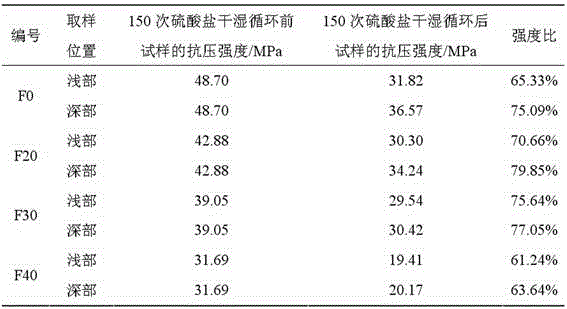Method for determining critical adding amount of coal ash in sulfate corrosion resisting concrete for cast-in-place pile
A technology of anti-sulfate and determination method, applied in chemical instruments and methods, clay preparation devices, data processing applications, etc., to achieve the effect of avoiding adverse effects
- Summary
- Abstract
- Description
- Claims
- Application Information
AI Technical Summary
Problems solved by technology
Method used
Image
Examples
Embodiment Construction
[0024] The following examples serve to illustrate the invention.
[0025] A method for determining the critical dosage of fly ash in the sulfate corrosion-resistant concrete for cast-in-place piles, comprising the following steps:
[0026] (1) Raw materials
[0027] The cementing material used is Tianshan brand P?O42.5 cement, grade Ⅱ fly ash, and the local aggregate in Xinjiang is selected. The coarse aggregate is continuously graded pebbles with a particle size of 5-31.5mm, and the fine aggregate is medium-coarse sand; Beijing Institute of Construction Engineering AN1000 high-efficiency water reducer.
[0028] (2) Determination of the critical dosage of fly ash
[0029] The chemical composition of the selected fly ash and cement is shown in Table 2. The content of mineral components in the cement measured by XRD is shown in Table 3. Combining the chemical composition of cement and fly ash in Table 2, it can be known that in this model a = 47%, b = 22%, c = 57.9%, put into...
PUM
 Login to View More
Login to View More Abstract
Description
Claims
Application Information
 Login to View More
Login to View More - R&D
- Intellectual Property
- Life Sciences
- Materials
- Tech Scout
- Unparalleled Data Quality
- Higher Quality Content
- 60% Fewer Hallucinations
Browse by: Latest US Patents, China's latest patents, Technical Efficacy Thesaurus, Application Domain, Technology Topic, Popular Technical Reports.
© 2025 PatSnap. All rights reserved.Legal|Privacy policy|Modern Slavery Act Transparency Statement|Sitemap|About US| Contact US: help@patsnap.com



